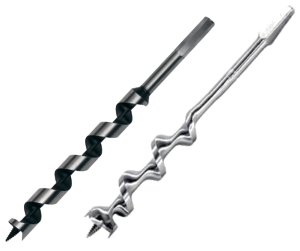Auger Bits: Difference between revisions
From DT Online
(Added Template) |
|||
| Line 16: | Line 16: | ||
[https://en.wikipedia.org/wiki/Boring_machine_%28carpentry%29 ''''T' Handled Hand Augers'''] and large [https://en.wikipedia.org/wiki/Auger_%28drill%29 '''Post Hole Borers''''] operate on the same general principles. | [https://en.wikipedia.org/wiki/Boring_machine_%28carpentry%29 ''''T' Handled Hand Augers'''] and large [https://en.wikipedia.org/wiki/Auger_%28drill%29 '''Post Hole Borers''''] operate on the same general principles. | ||
{{Auger Bits Buyers Guide}} | |||
[[Category:Drilling and Boring]] | [[Category:Drilling and Boring]] | ||
Revision as of 17:26, 14 May 2016
Description
Auger Bits were developed originally for use with a Carpenter's Brace and have a Tapered Square Shank. They are drawn into the wood by their screw tips and usually have two spurs which sever the wood Grain to help drill a neat hole.
Features and Uses
Two designs of Auger were developed in the 19th Century: Jennings Pattern (patented by Russell Jennings in 1855) and Irwin Pattern (patented by Charles Irwin in 1885). Modern designs are now available which are suitable for use in Portable Electric Drills and these have a Hexagonal Shank. Most Auger Bits can be sharpened using a file.
Note: Most wood bits will cause splitting if an attempt is made to drill straight through the material. Best practice is to drill from one side until the tip emerges on the reverse then turn the wood around and complete drilling from the other side.
'T' Handled Hand Augers and large Post Hole Borers' operate on the same general principles.









